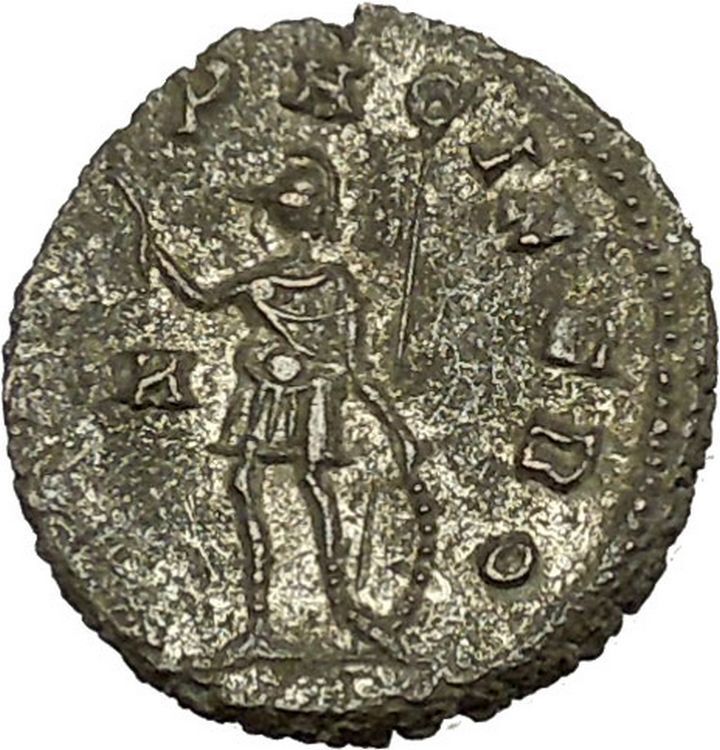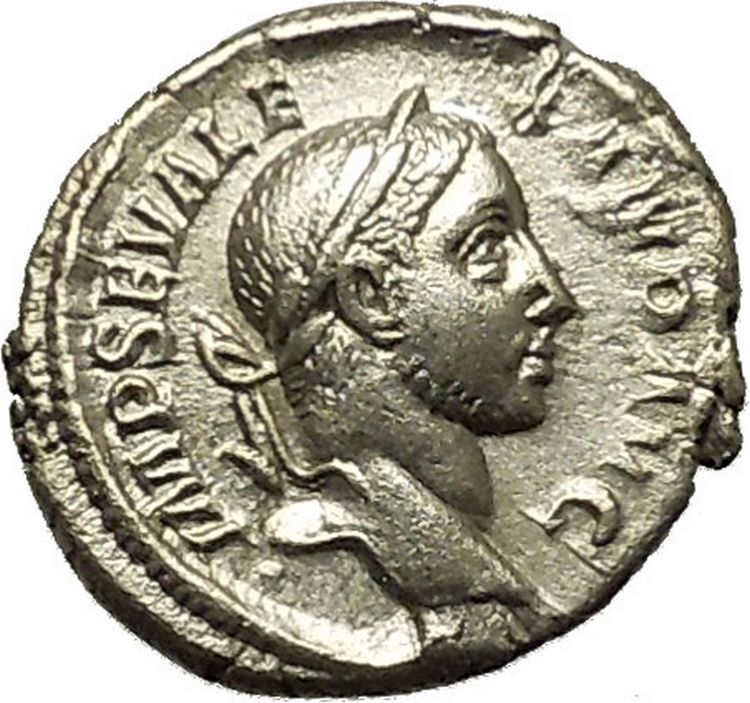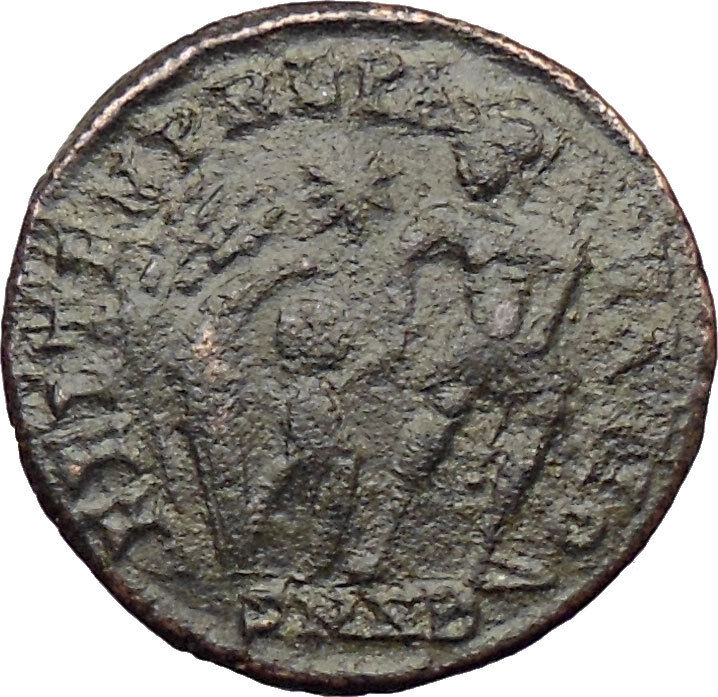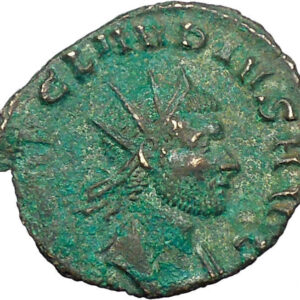|
Claudius II
Gothicus –
Roman Emperor
: 268-270 A.D.
Bronze Antoninianus 20mm (3.25 grams) Rome mint: 268-270 A.D.
Reference:RIC 57f, C 144
IMPCCLAVDIVSAVG – Radiate, cuirassed bust right.
LIBERALITASAVG – Liberalitas standing left, holding coin counter and cornucopia.
You are bidding on the exact item pictured,
provided with a Certificate of Authenticity and Lifetime Guarantee of
Authenticity.
The cornucopia (from Latin cornu copiae) or horn of plenty
is a symbol of abundance and nourishment, commonly a large horn-shaped container
overflowing with produce, flowers, nuts, other edibles, or wealth in some form.
Originating in
classical antiquity
, it has continued as a
symbol in
Western art
, and it is particularly associated
with the
Thanksgiving
holiday in
North America
.

Allegorical
depiction of the Roman
goddess
Abundantia
with a cornucopia, by
Rubens
(ca. 1630)
In Mythology
Mythology
offers multiple
explanations of the origin
of the cornucopia.
One of the best-known involves the birth and nurturance of the infant
Zeus, who had to be hidden from his devouring father
Cronus
. In a cave on
Mount Ida
on the island of
Crete
, baby Zeus was cared for and protected by
a number of divine attendants, including the goat
Amalthea
(“Nourishing Goddess”), who fed him
with her milk. The suckling future king of the gods had unusual abilities and
strength, and in playing with his nursemaid accidentally broke off one of her
horns
, which then had the divine power to
provide unending nourishment, as the foster mother had to the god.
In another myth, the cornucopia was created when
Heracles
(Roman
Hercules
) wrestled with the river god
Achelous
and wrenched off one of his horns;
river gods were sometimes depicted as horned. This version is represented in the
Achelous and Hercules
mural painting
by the
American Regionalist
artist
Thomas Hart Benton
.
The cornucopia became the attribute of several
Greek
and
Roman deities
, particularly those associated
with the harvest, prosperity, or spiritual abundance, such as personifications
of Earth (Gaia
or
Terra
); the child
Plutus
, god of riches and son of the grain
goddess Demeter
; the
nymph
Maia
; and
Fortuna
, the goddess of luck, who had the power
to grant prosperity. In
Roman Imperial cult
, abstract Roman deities who
fostered peace (pax
Romana) and prosperity were also depicted with a cornucopia,
including Abundantia
, “Abundance” personified, and
Annona
, goddess of the
grain supply to the city of Rome
.
Pluto
, the classical ruler of the underworld in
the
mystery religions
, was a giver of agricultural,
mineral and spiritual wealth, and in art often holds a cornucopia to distinguish
him from the gloomier Hades
, who holds a
drinking horn
instead.
Modern depictions
In modern depictions, the cornucopia is typically a hollow, horn-shaped
wicker basket filled with various kinds of festive
fruit
and
vegetables
. In North America, the cornucopia
has come to be associated with
Thanksgiving
and the harvest. Cornucopia is
also the name of the annual November Wine and Food celebration in
Whistler
, British Columbia, Canada. Two
cornucopias are seen in the
flag
and
state seal
of
Idaho
. The Great
Seal
of
North Carolina
depicts Liberty standing and
Plenty holding a cornucopia. The coat of arms of
Colombia
,
Panama
,
Peru and
Venezuela
, and the Coat of Arms of the State of
Victoria, Australia
, also feature the
cornucopia, symbolising prosperity.
The horn of plenty is used on body art and at Halloween, as it is a symbol of
fertility, fortune and abundance.
LIBERALITAS – Liberality, being one of the princely virtues and at the same
time a most popular quality, appears both as a legend and as a type on a great
many Roman imperial medals. These attest the occasions when the emperors made a
display of their generosity towards the people by all kinds of distributions
amongst them, in money and provisions. In the earlier age this was called Congiarium (Munus), because they distributed congios oleo plenos. In the time of
the free republic, the Ediles were specially entrusted with these distributions,
as a means of acquiring the good will of the people. The same practice was
followed under the emperors; and we occasionally find on their coins the word
CONGIARIVM, but the more common term is LIBERALITAS, to which is frequently
added the number of times that such liberality has been exercised by each
emperor.
On these occasions of imperial munificence, a certain sum of money was for the
most part given to each person, and when grain was distributed, or bread, to
prevent the evils of dearness and famine from affecting the Roman populace, it
was called Annona. But when something beyond their ordinary pay was bestowed
upon the soldiers, it was denominated Donativum, a word, however, not found on
coins, but comprised under that of Liberalitas, or of Congiarium; and after the
reign of Marcus Aurelius, CONGIARIVM is no longer found, and the expression
LIBERALITAS is alone employed.
Liberality is personified by the image of a woman, holding in one hand a
counting board, or square tablet with a handle on which are cut a certain number
of holes. These boards were used to quickly count the proper number of coins or
other items for distribution to each person. It appears they would be dipped
into a container, covered with coins and the excess swept away back into the
container. The proper number of coins would fill the holes and then would be
dumped out to the recipient. On coins this symbol indicated the prince had
given to the people money, corn, and other articles of consumption. In the other
hand she holds a cornucopia, to indicate the abundance of wheat contained in the
public granaries. Liberalitas is represented as presiding at all congiaria. The
liberalities of the Augusti, by which the distribution of their bounties to the
people is signified, were of two kinds, ordinary and extraordinary.
Marcus Aurelius Claudius (May
10, 213
– January, 270), often referred to as Claudius Gothicus or Claudius II,
was a Roman Emperor
. He ruled the
Roman
Empire
for less than two years (268 – 270), but during that brief time he
managed to obtain some successes. He was later given divine status.
//
Life
Origin
and rise to power
Claudius’ origin is uncertain. He was either from
Sirmium
(Syrmia;
in Pannonia
Inferior) or from Naissus
Dardania
(in
Moesia Superior
); both areas are located in
Serbia
.
Claudius was the commander of the Roman army that decisively defeated the
Goths
at the
Battle of Naissus
in September 268; in the same month, he attained the
throne, amid charges, never proven, that he murdered his predecessor
Gallienus
.
However, he soon proved to be less than bloodthirsty, as he asked the
Roman
Senate
to spare the lives of Gallienus’ family and supporters. He was less
magnanimous toward Rome’s enemies, however, and it was to this that he owed his
popularity.
Claudius, like
Maximinus Thrax
before him, was of barbarian birth. After an interlude of
failed aristocratic Roman emperors since Maximinus’s death, Claudius was the
first in a series of tough soldier-emperors who would eventually restore the
Empire from the
Crisis of the third century
.
Claudius
as emperor
At the time of his accession, the Roman Empire was in serious danger from
several incursions, both within and outside its borders. The most pressing of
these was an invasion of Illyricum and
Pannonia
by
the Goths
. Not
long after being named emperor (or just prior to Gallienus’ death, depending on
the source), he won his greatest victory, and one of the greatest in the history
of Roman arms.

The Roman Empire in 268 A.D
At the
Battle of Naissus
, Claudius and his legions routed a huge Gothic army.
Together with his cavalry commander, the future Emperor
Aurelian
,
the Romans took thousands of prisoners, destroyed the Gothic cavalry as a force
and stormed their laager (a circular alignment of wagons long favored by the
Goths). The victory earned Claudius his surname of “Gothicus” (conqueror of the
Goths), and that is how he is known to this day. More importantly, the Goths
were soon driven back across the
Danube River
, and a century passed before they again posed a serious threat
to the empire.
While this was going on, the Germanic tribe known as the
Alamanni
had crossed the Alps
and attacked the empire. Claudius responded quickly, routing the Alamanni at the
Battle of Lake Benacus
in the late fall of 268, a few months after the
battle of Naissus. He then turned on the
Gallic Empire
, ruled by a pretender for the past fifteen years and
encompassing
Britain
, Gaul
,
and the
Iberian Peninsula
. He won several victories and soon regained control of
Spain and the Rhone river valley of Gaul. This set the stage for the ultimate
destruction of the Gallic Empire under Aurelian.
However, Claudius did not live long enough to fulfill his goal of reuniting
all the lost territories of the empire. Late in 269 he was preparing to go to
war against the Vandals
, who were raiding in
Pannonia
.
However, he fell victim to the
Plague of Cyprian
(possibly
smallpox
),
and died early in January 270. Before his death, he is thought to have named
Aurelian as his successor, although Claudius’ brother
Quintillus
briefly seized power.
The Senate
immediately deified Claudius as “Divus Claudius Gothicus”.
Links
to
Constantinian dynasty
The
Historia Augusta
reports Claudius and Quintillus having another brother
named Crispus and through him a niece. Said niece Claudia reportedly married
Eutropius and was mother to
Constantius Chlorus
. Historians however suspect this account to be a
genealogical
fabrication intended to link
Constantine I
‘s family to that of a well-respected emperor.
|










